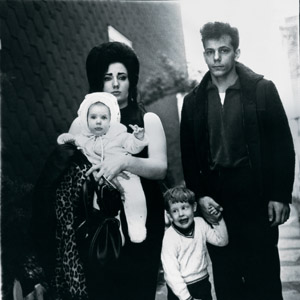
A Young Brooklyn family going for an outing NYC 1966
© Estate of Diane Arbus
What of the images chosen for this book? The first is obvious, Fox Talbot's abbey window from 1835 is one of those images taken as the "first" photographic image, and its story is well-known. The second image is Negre's "Chimney Sweeps Walking" and was made in 1852 before it was technically possible to actually capture anyone walking. The image shows the very early manipulation of both the story and the image itself as there is good evidence of "post-processing" of the negative and the print.
Julia Margaret Cameron (1867), Man Ray and Marcel Duchamp (1920), and Bill Brandt (1937) all represent the photographer as artist pure and simple. Diane Arbus (1966), Martin Parr (1977) and Nan Goldin (1980) might be taken to represent the post-"decisive moment" era of street photography, reportage and social commentary. The era when small cameras and fast emultions allowed photographers to go out and capture life unawares.
Hiroshi Sugimoto (1990) and to a lesser extent Thomas Struth (1995) represent the more conceptual aspects of modern art, with their reliance on the underlying idea and their self-reference to art.
Finally, Jeff Wall (2004-5) seems to represent a return to the pictorialism of Ms. Cameron (or perhaps Oscar Rejlander), with his artificial reality of multiple image, lighting and staging.
Flipping through the book it's obvious that this is not a Kodak Guide to Good Photos. The images here require interpretation in order to take them from looking like a snapshot (for instance, Struth's "San Zaccaria, Venice" could, at first glance, be any tourist's souvenir) to art. While I was somewhat surprised to see the selection on first glance, I am happy enough with the images and the essays to recommend this book to anyone who is interested in the art of photography.